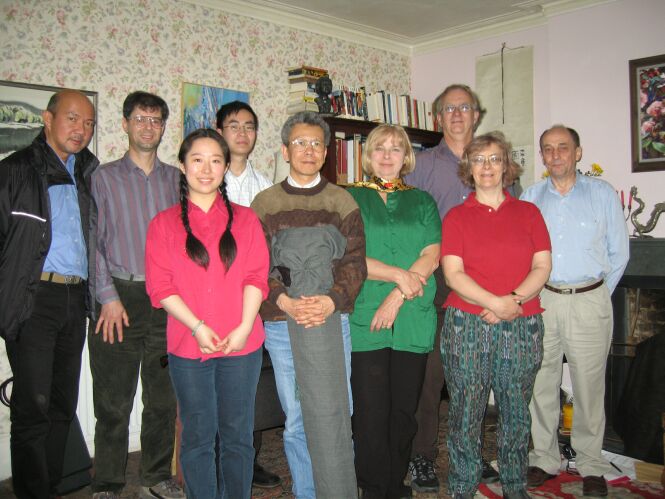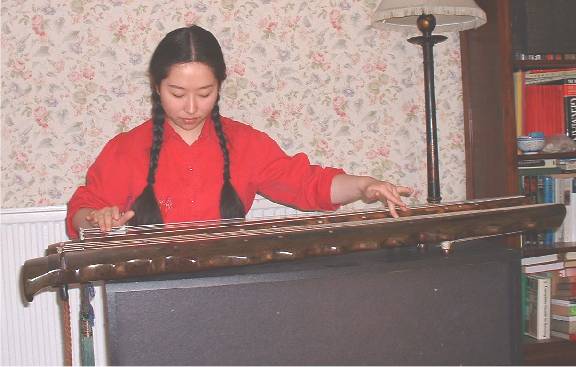1st May 2005
This, the 13th meeting of the London Youlan Qin
Society, was held at the home of Sarah Moyse in southwest London.
 Programme
Programme
- Wang Tingting: Meihua San Nong, Yangguan San Die [sung]%
- Chen Jinwei: Xiao Xiang Shui Yun, Ao Ai%
- Dan Nung Ing: El Testament d'Amelia#
- Christopher Evans: Liang Xiao
Yin*
- Charlie Huang: Feng Lei Yin, Feng Qiu Huang*
- Julian Joseph: Shishang Liu Quan* , Tian Lai*
- Marnix Wells: Guangling San#
* Played on a qin made by Zeng Chengwei
in Chengdu, southwestern China, less than 1 year ago, with
steel/nylon strings.
# Played on a qin made by Wang
Peng in Beijing with silk strings
% Played on a qin made by Li
Guangyi of Hangzhou with steel/nylon strings
Introduction
 Tingting Wang began the proceedings with a rendition of Meihua
San Nong, followed by Cheng Jinwei with Xiao Xiang Shui Yun.
Then Dan Nung Ing gave a talk on the work he has been doing on qin string
tensions.
Tingting Wang began the proceedings with a rendition of Meihua
San Nong, followed by Cheng Jinwei with Xiao Xiang Shui Yun.
Then Dan Nung Ing gave a talk on the work he has been doing on qin string
tensions.
String tension in silk and steel/nylon strings
There is debate as to whether the tension of steel/nylon strings is
greater than that of silk, and whether the use of steel/nylon styrings
is therefore detrimental to a qin.
Dan Nung described the experiments he had been carrying ut to compare
the relative tensions of silk and steel/nylon strings. For details,
please click here.
Dan Nung's talk led to much discussion, which may be summarised as
follows:
There is nothing wrong with changing the grouping of the strings,
but neither is there any reason to break with tradition. The difference
in the balance of the forces is too small to matter, and a qin is much stronger than a guitar.
But there may be an effect on tone colour. Resonance of the whole
instrument can generate second and third order harmonics. This may be
affected by other factors - string tension, the way they are attached
to
the body of the instrument, the sizes of the strings, the resonating
chamber and how it is braced, how the strings are attached at the back.
It was suggested that it may be to do with the generation of harmonics,
which pass through the wood because the
strings are all attached at the same point. Alternatively, it may be
caused by distortion of the wood: horizontal bending
leading to torsion. There are tonal differences between guitars
depending on the type
of bridge and whether the strings pass through the body
or are hooked underneath.
It may be possible to improve the sound of steel/nylon strings by
making them heavier: heavier strings at higher tension give a
more rounded, more beautiful sound. The highest strings on a qin are actually
underweight, giving a thinner sound. This could be improved by making
the ratio of weight to tension
closer to that of silk by making these strings thicker. For example one
could use another string 6 for the top
string. Guitarists tend to use thicker strings at higher tension,
so they tune down a semitone, from E to E flat or even D.
Music
Dan Nung Ing learned the classical guitar some 20 or 30 years ago. He
felt
some classical guitar pieces were eminently suitable for transposing to
the
guqin. He played one such piece, a well known Catalan folk song
called
"El Testament d'Amelia" which he had just started to work on. It
was transcribed for the classical guitar by Miguel Llobet, and
students
of the classical guitar learn to play it after about 18 months of
study. Tingting Wang, who is doing her PhD on qin songs (qinge), sang "Yangguan San Die". In keeping with qinge tradition, she used her own
(Changsha) dialect. She gave us all copies of the words, so everyone
who
could read Chinese could (and did) join in. The original words are
those of Wang Wei's famous poem, but they were later added to. The
music is from the 19th century qin handbook
Qinxue Rumen. Chen Jinwei
played Ao Ai. These two words
have no
meaning, but are onomatopoeic, describing the sound of an oar. They
come from a Tang Dynasty poem by Liu Zongyuan, about a fisherman. The
piece creates a very Daoist mood.
Copyright the London Youlan Qin Society,
2005. All
rights reserved.
 Programme
Programme Programme
Programme Tingting Wang began the proceedings with a rendition of Meihua
San Nong, followed by Cheng Jinwei with Xiao Xiang Shui Yun.
Then Dan Nung Ing gave a talk on the work he has been doing on qin string
tensions.
Tingting Wang began the proceedings with a rendition of Meihua
San Nong, followed by Cheng Jinwei with Xiao Xiang Shui Yun.
Then Dan Nung Ing gave a talk on the work he has been doing on qin string
tensions.